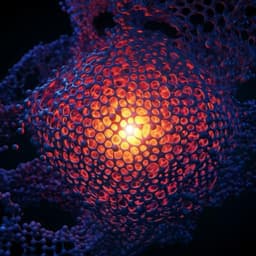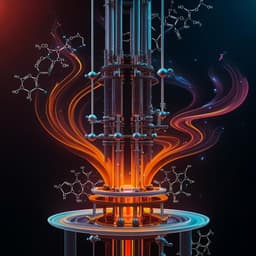
Chemistry
Radical strain-release photocatalysis for the synthesis of azetidines
R. I. Rodríguez, V. Corti, et al.
Discover a groundbreaking method developed by Ricardo I. Rodríguez and team that synthesizes densely functionalized azetidines using a novel photocatalytic radical strategy! This innovative approach showcases remarkable efficiency and versatility, opening doors to new azetidine derivatives, including celecoxib and naproxen.
~3 min • Beginner • English
Introduction
Nitrogen-containing heterocycles are highly prevalent in drugs and agrochemicals, with over 60% of marketed pharmaceuticals containing at least one N-heterocycle. There is a growing shift from planar heteroaromatics toward 3D-rich, high-Fsp3 architectures due to advantages in metabolic stability and modularity. The azetidine ring is a privileged scaffold capable of bioisosterically mimicking pyridine, piperidine, and pyrrolidine, yet only nine approved drugs currently bear the azetidine core, reflecting synthetic challenges. Classical routes to azetidines (intramolecular displacement or β-lactam reduction) often suffer from low functional group tolerance and the need for tailored precursors. The visible-light aza-Paternò–Büchi approach is milder but can suffer from unpredictable regio- and diastereoselectivity. Strained 1-azabicyclo[1.1.0]butanes (ABBs) enable predictable two-bond installations via electrophile/nucleophile pairing, but generality is limited by the need for specific electrophiles and/or strong acid conditions. Despite advances in visible-light photocatalysis and radical strain-release (RSR) approaches for small rings, no radical ABB strain-release strategy to access azetidines had been demonstrated. The authors propose generating two radicals via photocatalytic triplet sensitization of sulfonyl imines that selectively engage ABBs to trigger strain-release, resulting in a predictable, double functionalization at nitrogen and C3 of the azetidine.
Literature Review
The study builds on several strands of prior work: (1) Synthetic access to azetidines by intramolecular displacement and β-lactam reduction, which face scope and selectivity limitations. (2) Visible-light-driven aza-Paternò–Büchi reactions that enable milder synthesis of azetidines but can suffer from variable regio- and diastereoselectivity. (3) ABB strain-release chemistry enabling polar, two-vector functionalization under electrophile/nucleophile regimes, though often requiring strong acids or specific partners, limiting generality. (4) Energy-transfer photocatalysis and radical strain-release photocatalysis have enabled construction of small carbocycles; however, N-heterocyclic RSR examples have been lacking. The authors’ approach addresses this gap by combining ABB strain-release with photocatalytic triplet energy transfer to activate sulfonyl imines into iminyl and sulfonyl radicals, thereby forging C–S, C–N, and C–H bonds in azetidines under mild conditions with an organic photosensitizer designed for a small singlet–triplet energy gap.
Methodology
Reaction design and optimization: To avoid deleterious single-electron oxidation of ABBs, the authors chose a triplet energy-transfer (EnT) strategy using sulfonyl imines as radical precursors. Initial screening showed that photosensitizers with high T1 energy (>2.55 eV) and a very small ΔEST (S1–T1 gap) modulate the rate of imine sensitization, suppressing imine dimerization and favoring product formation. An organic PS (9), inspired by thermally activated delayed fluorescence (TADF) emitters, with ΔEST ≈ 0.05 eV and T1 Eop ≈ 2.74 eV, was identified as optimal at 0.25 mol% loading. Key reaction conditions: ABB (1) 0.1 mmol (2 equiv), sulfonyl imine (2) 0.05 mmol (1 equiv), PS 9 (0.25 mol%) in trifluorotoluene (PhCF3), irradiated with a 50 W Kessil blue lamp (λ ≈ 456 nm) at 40 °C under argon for 22 h; degas via three freeze–pump–thaw cycles. Workup by concentration and purification of the solid product. No reversed isomer with sulfonyl at C3 was observed. Mechanistic studies: Time-correlated single-photon counting showed the singlet of PS 9 is unreactive toward ABB or imine. Laser flash photolysis (LFP) demonstrated efficient quenching of PS 9 triplet by imine 2 (kq = 2.6 × 10^8 M^−1 s^−1) but much weaker by ABB 1 (k = 3.7 × 10^6 M^−1 s^−1), consistent with EnT to the imine. LFP of PS 9 with 2 indicated formation of radicals 10 (sulfonyl) and 11 (iminyl). Direct excitation of 2 in the presence of 1 revealed a transient at 410 nm (tosyl radical 10), followed by a new transient with λmax 435 nm assigned to the ABB-opened C3-centered radical 12; its growth scales with ABB concentration. EPR spin-trapping (PBN) detected nitrogen- and sulfur-centered radicals (10 and 11) in the absence of ABB; under reaction conditions, multiple species were trapped with the major component (~70%) consistent with radical 12. Computations: DFT at (U)M062x/def2TZVP with IEFPCM (toluene) computed EnT from 9 to imine 2a as exergonic (ΔG = −9.2 kcal mol^−1). N–S bond homolysis post-sensitization is exergonic (ΔG = −10.3 kcal mol^−1) with ΔG‡ = 8.1 kcal mol^−1. Addition of sulfonyl radical to ABB forms radical 12, which combines with iminyl radical to give product. The unobserved isomer (sulfonyl at C3) is calculated to be 21.9 kcal mol^−1 less favorable than the observed product, and formation is kinetically disfavored (ΔG‡ = 55.1 kcal mol^−1 vs 17.0 kcal mol^−1 along the productive path). Scope studies: Broad evaluation of sulfonyl imines (ketimines and aldimines) with varied electronics; multiple sulfonyl substituents tested; diverse ABBs including aryl-, carbonyl-, and 2-substituted variants assessed. Three-component variant: Leveraging lower iminyl generation from aldimines, a three-component format was designed: ABB 1 (2 equiv), aldimine (39–41, 1 equiv), and SOMOphile (supersilane 42 or phthalimide–SCF3 43) in ethyl acetate with PS 9 (0.25 mol%), 456 nm, Ar, 40 °C, 22 h, giving C3–H or C3–SCF3 insertion products. Synthetic manipulations: Downstream transformations revealed amine functionalities via reductions, hydrolyses to hydrochloride salts, neutralization to free amines, tosyl deprotection, ring closures, and oxidative arene cleavage to form a spiroazetidine.
Key Findings
- An organic TADF-inspired photosensitizer (PS 9) with very small ΔEST (0.05 eV) and high triplet energy (T1 Eop ≈ 2.74 eV) enables controlled triplet energy transfer to sulfonyl imines, minimizing imine dimerization and favoring azetidine formation. No reversed isomer with sulfonyl at C3 was detected. - Mechanistic evidence supports EnT-initiated homolysis of the N–S bond in sulfonyl imines to form sulfonyl and iminyl radicals. LFP shows PS 9 triplet quenching by imine 2 (kq = 2.6 × 10^8 M^−1 s^−1) vs ABB 1 (3.7 × 10^6 M^−1 s^−1). Transient at 410 nm (tosyl radical 10) and 435 nm (ABB-opened radical 12) observed; EPR trapping shows 12 as the major radical under reaction conditions (~70%). - DFT indicates the EnT step is exergonic (ΔG = −9.2 kcal mol^−1); N–S cleavage is exergonic (ΔG = −10.3 kcal mol^−1, ΔG‡ = 8.1 kcal mol^−1). Product formation via radical 12 is kinetically preferred; the alternative isomerization pathway is highly disfavored (ΔG‡ = 55.1 kcal mol^−1). - Scope: Diverse sulfonyl imines (ketimines/aldimines, EWG/EDG) furnish azetidines in up to 79% yield; varied sulfonyl groups give 47–80% yields. ABB variants (aryl and carbonyl-bearing) give up to 84% yield; 2-substituted ABBs afford up to 82% yield with diastereomeric mixtures (e.g., 30:70 d.r., 1:1 d.r.), with configurations confirmed by X-ray for selected cases. - Late-stage compatibility: Celecoxib-derived imine provides product in 71% yield; a chiral naproxen-derived ABB gives 66% yield while preserving >99% ee. - Three-component extension: Using supersilane (42) with aldimines affords C3-hydrogenation-type products in up to 91% yield; phthalimide–SCF3 (43) enables C3–SCF3 installation in up to 71% yield, including celecoxib derivatives. - Synthetic utility: Efficient unveiling and diversification of amine functionalities (e.g., formation of benzylated amines up to 95% yield, hydrochloride salts quantitatively, tosyl deprotection to 3-aminoazetidines, ring closures to kinase-modulator-like scaffolds, and oxidative arene cleavage to a spiroazetidine in 52% yield).
Discussion
The work addresses the lack of a general radical strain-release approach to azetidines by merging ABB ring-opening with photocatalytic triplet energy transfer to sulfonyl imines. Key to success is the photosensitizer design, which precisely controls the rate of imine activation by balancing singlet and triplet populations, thus suppressing competitive dimerization and channeling reactivity into ABB capture. Mechanistic experiments (EnT selectivity, LFP, EPR) and DFT calculations cohere to a pathway in which sulfonyl radicals add to ABB at C3 to form a persistent carbon-centered radical 12 that undergoes selective radical–radical combination with the iminyl partner, delivering difunctionalized C3–N sulfonyl azetidines. The methodology demonstrates broad substrate scope, tolerance of pharmaceutically relevant motifs, and late-stage functionalization potential. The three-component variant shows that the key intermediate 12 can be diverted to other SOMOphiles, expanding the synthetic reach without re-optimizing conditions. Overall, the findings establish ABBs as competent partners in RSR photocatalysis for N-heterocycles and provide predictable access to two-vector azetidines, addressing shortcomings of existing approaches in selectivity and generality.
Conclusion
An organic photosensitizer engineered for a small singlet–triplet gap enables finely tuned triplet energy transfer to sulfonyl imines, triggering N–S homolysis and radical generation. The resulting sulfonyl and iminyl radicals undergo polarity-matched engagement with ABBs via radical strain release, delivering densely functionalized C3–N sulfonyl azetidines in one step under mild conditions. Mechanistic spectroscopy and DFT support the proposed EnT-driven pathway and rationalize the selectivity. The platform exhibits broad scope, accommodates complex drug-like fragments, and can be extended to three-component variants (e.g., H- and SCF3-installation) and downstream amine manipulations, furnishing versatile azetidine building blocks. Future directions include leveraging ABBs in additional RSR manifolds, expanding SOMOphiles beyond those demonstrated, and exploring enantioselective variants or photocatalyst designs to improve stereocontrol.
Limitations
- The method relies on a specialized organic photosensitizer (PS 9) with a very small ΔEST; alternative PSs can lead to imine dimerization and lower yields, indicating a narrow optimal catalyst window. - Oxygen-free conditions, controlled temperature (40 °C), and extended irradiation (22 h) are required; scalability may require careful light and mass-transfer management. - Aldimines are less efficient than ketimines as iminyl sources, which motivated the three-component workaround. - Diastereoselectivity can be modest for 2-substituted ABBs (e.g., 30:70 d.r., 1:1 d.r.), necessitating separation or further optimization for stereochemical control. - Some substrate classes and additional limitations are noted in Supplementary Fig. 39 (not detailed in the main text). - Competing imine dimerization can occur under non-optimized conditions; careful tuning of PS loading, absorption properties, and solvent is necessary.
Related Publications
Explore these studies to deepen your understanding of the subject.







